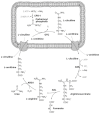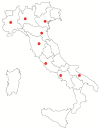Long-Term Management of Patients with Mild Urea Cycle Disorders Identified through the Newborn Screening: An Expert Opinion for Clinical Practice
- PMID: 38201843
- PMCID: PMC10780676
- DOI: 10.3390/nu16010013
Long-Term Management of Patients with Mild Urea Cycle Disorders Identified through the Newborn Screening: An Expert Opinion for Clinical Practice
Abstract
Urea cycle disorders (UCDs) are a group of rare inborn errors of metabolism caused by a deficiency in one of the six enzymes or one of the two transporters involved in the urea cycle. Current guidelines suggest that early diagnosis and treatment of mild UCDs may improve survival and prevent decompensation and neurocognitive impairment. Nevertheless, clinical studies are very difficult to carry out in this setting due to the rarity of the diseases, and high-level evidence is scant and insufficient to draw conclusions and provide clinical guidelines. With the early introduction of newborn screening, the Italian healthcare organization fostered an advancement in expertise in metabolic disease management and screening programs, by allocating resources, and favoring the expansion of newborn screening. A group of experts operating in Italian centers decided to share their experience and provide advice for the management of mild UCDs in clinical practice. A consensus was reached by the Estimate-Talk-Estimate (ETE) method. Five items were identified, and statements for each item were agreed. Briefly, the panel advised completing the diagnosis by expanded newborn screening (ENS) with biochemical and genetic confirmation and by following up with the patient during the first year of life, with a routine laboratory and metabolic profile as well as with clinical observation. Early initiation of therapy is advised and should be followed by therapy adjustment once the diagnostic profile is completed. The therapy should be based on a low-protein diet and nitrogen scavengers. The long-term follow-up is based on growth and nutritional assessment, clinical and neurocognitive evaluation, and laboratory and instrumental parameter monitoring.
Keywords: expanded newborn screening; follow-up; nitrogen scavengers; urea cycle disorders.
Conflict of interest statement
The authors have no relevant financial or non-financial interests to disclose.
Figures
References
-
- Ah Mew N., Simpson K.L., Gropman A.L., Lanpher B.C., Chapman K.A., Summar M.L. Urea Cycle Disorders Overview. In: Adam M.P., Mirzaa G.M., Pagon R.A., Wallace S.E., Bean L.J.H., Gripp K.W., Amemiya A., editors. GeneReviews. University of Washington; Seattle, WA, USA: 2003. pp. 1993–2023.
-
- Ruoppolo M., Malvagia S., Boenzi S., Carducci C., Dionisi-Vici C., Teofoli F., Burlina A., Angeloni A., Aronica T., Bordugo A., et al. Expanded Newborn Screening in Italy Using Tandem Mass Spectrometry: Two Years of National Experience. Int. J. Neonatal Screen. 2022;8:47. doi: 10.3390/ijns8030047. - DOI - PMC - PubMed
-
- Bin Sawad A., Jackimiec J., Bechter M., Trucillo A., Lindsley K., Bhagat A., Uyei J., Diaz G.A. Epidemiology, methods of diagnosis, and clinical management of patients with arginase 1 deficiency (ARG1-D): A systematic review. Mol. Genet. Metab. 2022;137:153–163. doi: 10.1016/j.ymgme.2022.08.005. - DOI - PubMed
MeSH terms
Grants and funding
LinkOut - more resources
Full Text Sources




